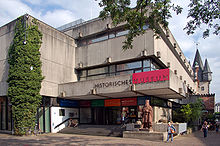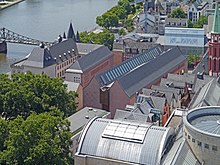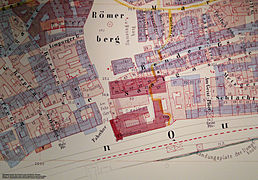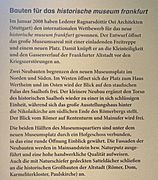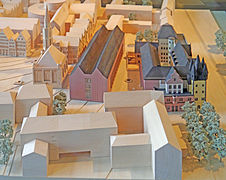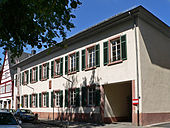Historical Museum Frankfurt
The Historical Museum (HMF) of Frankfurt am Main was founded in 1877/1878 on the basis of civic initiatives with the task of “acquiring suitable objects from the entire area of cultural and art antiquities with special consideration of the city of Frankfurt am Main and its surroundings and through to make scientific research usable ”. The museum should be an educational institution and keep the memory of the time of the Free City of Frankfurt alive.
The museum is located in Frankfurt's old town south of the Römerberg , between the Alte Nikolaikirche and the Mainkai . The still intact Freudenberg House , which was one of the few old town houses to survive the Second World War , was demolished for the new exposed concrete building of the Historical Museum in 1972 . The part built in 1972 was again demolished in 2011 and replaced by a new building. The museum was closed until the beginning of 2012 due to renovation and renovation work on the old buildings (before 1971). On May 26, 2012 the refurbished existing building was opened and the new building on October 7, 2017.
history
After the First World War , the Historical Museum limited itself to the role of a Frankfurt local history museum . Important exhibits were sold or given to other museums, including the Städel and the Museum of Arts and Crafts (now the Museum of Applied Art ). In 1934 the museum was renamed the City History Museum. In 1937 the archaeological department was spun off as an independent museum for prehistory and early history (today's Archaeological Museum ).
Until the destruction of the historic old town of Frankfurt by the air raids on Frankfurt am Main in the bombing war in 1944, the exhibitions were housed in various historical buildings, including the canvas house . All files, parts of the library and all permanently installed exhibits were lost in the war. Most of the exhibits had been relocated in 1942, which did not protect against destruction in all cases. 95 paintings have been lost and are still missing, including the Revolutionary People's Assembly in Ostpark on November 9, 1918 by Erich Grube , Frankfurt seen from the Goethe Tower by Mateo Cristiani and Battery of the Field Artillery Regiment 63 by Joseph Kaspar Correggio .
After the war, the museum was renamed the Historical Museum again and the idea of an educational institution was revived. In November 1955, the museum administration and the graphic collection moved into the Burnitz building in the historic Saalhof on the Römerberg. From March 1956, the Bernus building, which was still provided with an emergency roof, served as a depot for the museum. The reopening of the museum took place on July 13, 1957 in the makeshift Saalhof. The exhibition rooms were in the Bernusbau . The workshops and offices were located in the Burnitz building. The Staufer Saalhof Chapel initially remained in ruins and was only renovated from 1966 to 1967.
In 1971 the construction of an extension wing on Saalgasse began , the first phase of which was opened in October 1972. For this project, the front of the timber frame house was Wertheim lying house Freudenberg (Am Fahrtor 6, formerly Brabant called), demolished, as well as a Gothic doorway, a remnant of the house Red crab (Am Fahrtor 4). The Freudenberg House was a classicist building with three upper floors that was built after 1833.
The windowless new building made of exposed concrete elements in the brutalism style drew a lot of criticism from the start. The building's visual guidance system came from the graphic designer Herbert W. Kapitzki . The new permanent exhibition on Frankfurt's history installed in the new building was also heavily criticized. Most of the objects in the collection were exhibited in a viewing depot accessible on request. In the publicly accessible exhibition rooms themselves, an anti-capitalist-inspired city history could be read on numbered text panels. The section on the 20th century and the Frankfurt council movement was particularly controversial.
New building
After a temporary renovation was considered, the city decided in February 2007 to demolish the concrete building and replace it with a new building with a sandstone facade, which, from the city's point of view, fits better into the historical development of the Römerberg with the neighboring Haus Wertheim and the old Nikolaikirche should insert. As part of the new building, the exhibition area of the Historical Museum was increased to around 5,000 square meters for the permanent exhibition and 800 to 1,000 square meters for temporary exhibitions.
The Stuttgart architects Lederer + Ragnarsdóttir + Oei emerged as the winner of the architectural competition. The museum was closed for the duration of the removal, demolition and construction preparation work in early 2011. The demolition party took place on May 7, 2011, after which the exposed concrete building was removed.
The larger than life sculpture of Charlemagne , created in 1843 from Main sandstone by the sculptor Johann Nepomuk Zwerger , stood in front of the museum entrance until May 2011 . Its original location was the old bridge until 1914 - when it was replaced by today's new building .
Construction began on the new building in 2012. In the meantime, the historic parts of the building were reopened on May 26, 2012. For the first time since then, the pension tower has also been open to the public. An important aspect of the redesign was the visualization of the building history of the complex from the different epochs of its history. The new building was opened on October 7, 2017.
Directors
- 1873–1907 Otto Cornill
- 1907–1908 Otto Lauffer
- 1908–1927 Bernhard Müller
- 1930–1938 Adolf Feulner
- 1938–1954 Ernstotto zu Solms-Laubach
- 1954–1960 Gerhard Bott
- 1960–1982 Hans Stubenvoll
- 1982-2005 Rainer Koch
- since April 2005 Jan Gerchow
Permanent exhibition
Before the opening of the new building (2017), the museum showed the following permanent exhibitions:
- "From the Palatinate to the early city - Frankfurt in the Middle Ages"
- “Frankfurt in the late Middle Ages. Church - Founder - Piety "
- "16.-18. Century - from the Reformation to the Enlightenment "
- "From Strangers to Frankfurters - Immigration and Coexistence"
- "MainMetropole: Frankfurt City History 1866 to 2001"
The historical topography of Frankfurt history from the Middle Ages to the present day was on the ground floor of the Burnitz building and the Saalhof chapel, the oldest preserved building in the city, dating from around 1160 . The focus of this exhibition was the model of the historic old town created by the brothers Hermann (1876–1962) and Robert Treuner (1877–1948) between 1926 and 1955 .
Since the opening of the new building on October 7, 2017, the following permanent exhibitions have been shown:
- “Staufer time” - the time of the Staufer in the 12th to 13th centuries is the focus in the basement of the Saalhof.
- Rent tower and main panorama
- "Frankfurt collectors and donors"
- "The snow globe - 8 x Frankfurt"
- "Frankfurt once?"
- "Frankfurt Now!"
Significant exhibits
The Anne Altar from the Dominican Church ( Master of Frankfurt around 1505)
The Heller Altar from the Dominican Church ( Albrecht Dürer and Matthias Grünewald around 1507–1511)
The reconciliation of King Otto with his brother Heinrich in Frankfurt am Main in 941 ( Alfred Rethel 1840)
Special and changing exhibitions (selection)
- The Emperor Makers - On the occasion of the 650th anniversary of the Golden Bull (September 30, 2006 - January 14, 2007)
- Change of look. Frankfurt women around 1800 (23 August - 25 November 2007)
- Frankfurt and the North Pole. Explorers and researchers in the eternal ice: 1861–1931 (December 22, 2007 - March 9, 2008)
- The 68s - Short summer, long impact (May 1 - August 31, 2008)
- Liselotte Strelow (1908–1981) - retrospective (January 22 - April 13, 2009)
- Peter Struwwel - Heinrich Hoffmann . A life in Frankfurt 1809–1894 (June 13, 2009 - September 21, 2009)
- Frankfurt's democratic modernity and Leopold Sonnemann . Jew - publisher - politician - patron (October 29, 2009 - February 28, 2010)
- Targeting Strangers - World War II Photo Albums (April 15 - August 29, 2010)
- If (not only) architects are allowed to dream ... New project ideas for Frankfurt (9 September - 3 October 2010)
- Abisag Tüllmann (1935–1996). Photo reports and theater photography (November 24, 2010 - March 27, 2011)
- Early plastics - the collection of the cultural scientist Eva Stille (August 18 - March 31, 2013)
- Third World in World War II - A Forgotten Chapter of History (September 27, 2013 - April 7, 2014)
- My grandparents (September 12, 2012 - February 24, 2013)
- Drago Trumbetaš : Guest workers in Frankfurt (May 2 - September 15, 2013)
- The new citizen city - The Frankfurt of the architects Burnitz (October 31, 2013 - February 16, 2014)
- The Holzhausen . Frankfurt's oldest family (May 10 - July 27, 2014)
- Captured images. Science and Propaganda in World War I (September 14, 2014 - February 15, 2015)
- Silk robes and leather jackets - The Erika Segel-Reinhardt fashion studio (4th July - 11th October 2015)
- The making of HMF - A new museum for Frankfurt (October 7, 2017 - July 15, 2018)
- Ladies choice! 100 years of women's suffrage (August 26, 2018 - January 20, 2019)
- Forgetting - Why We Don't Remember Everything (March 7th - July 14th, 2019)
- Dresses on the move - women's fashion since 1850 (May 5, 2020 - January 24, 2021)
Branches
The Children's Museum has been affiliated to the Historical Museum since 1972 , which prepares urban and art history topics especially for children, and the Porcelain Museum in Höchst. The Caricatura Museum was initially a branch, but was released in 2019.
Caricatura
The museum for comic art in the canvas house collects the works of important caricaturists . One focus is the New Frankfurt School . In autumn 2005 the city acquired around 5,000 works by FW Bernstein , Robert Gernhardt , Chlodwig Poth , Hans Traxler and FK Waechter . In the future, they are to form the core of the collection and thus bind the Caricatura permanently to Frankfurt. Since April 1, 2019, Caricatura has been an independent institution; This was preceded by a rift between founding director Achim Frenz and the superior director of the Historical Museum Jan Gerchow.
Porcelain museum in the Kronberg house
In Kronberger Haus in Frankfurt-Hoechst is since 1994 a branch of the Historical Museum. Around 1,000 pieces of faience and porcelain from the Höchst Porcelain Manufactory are on display here.
See also
literature
General
- Jan Gerchow (Ed.): 100 x Frankfurt: Stories from (more than) 1,000 years. Societäts-Verlag, Frankfurt am Main 2017, ISBN 978-3955422622 .
- Detlef Hoffmann , Almut Junker, Peter Schirmbeck (eds.): History as a public nuisance or: A museum for democratic society: the historical museum in Frankfurt a. M. and the dispute over his conception. Anabas-Verlag, Fernwald-Steinbach 1974.
collection
- Reinhard Glasemann: Earth, Sun, Moon & Stars: Globes, sundials and astronomical instruments in the Historical Museum in Frankfurt am Main. Kramer, Frankfurt am Main 1999, ISBN 978-3782905046 .
Exhibition catalogs
- Frank Berger (ed.): Faith, Power, Art, Antwerp - Frankfurt around 1600. (Catalog for the exhibition of the same name 2005–2006, Historisches Museum Frankfurt am Main and Hessenhuis, Antwerp). Societäts-Verlag, Frankfurt am Main 2005, ISBN 978-3-7973-0970-9 .
- Petra Bopp: Strangers in Sight - Photo albums from the Second World War. (Catalog for the exhibition of the same name, cooperation between the Oldenburg City Museum, the Photography Collection in the Munich City Museum, the Jena City Museum and the Frankfurt Historical Museum). Kerber Verlag, Bielefeld 2009, ISBN 978-3-86678-312-6 .
Web links
- Literature from and about the Historisches Museum Frankfurt in the catalog of the German National Library
- Historical Museum Frankfurt
- Children's Museum Frankfurt
- Caricatura Museum Frankfurt
- The highest porcelain museum in the Kronberg house
Individual evidence
- ↑ Article “We about us” on historisches-museum.frankfurt.de
- ^ The new building of the Historical Museum ( Memento from April 1, 2012 in the Internet Archive ) at aufbau-ffm.de
- ↑ Schulze, Mario: How things learned to speak A history of the museum object 1968–2000 . 1st edition. transcript, Bielefeld 2017, ISBN 978-3-8376-3915-5 .
- ^ Kittel, Manfred, 1962-: March through the institutions? Politics and culture in Frankfurt after 1968 . Oldenbourg, Munich 2011, ISBN 978-3-486-71231-5 , pp. Cape. 3 .
- ↑ "Signs of Brutalism" disappears from the city
- ↑ Frankfurter Allgemeine Zeitung of November 21, 2013
- ^ Tilman Spreckelsen: The double look in the city mirror. faz.net, October 7, 2017, accessed October 14, 2017 .
- ^ Museum dispute in Frankfurt: The Caricatura Museum becomes independent. In: www.faz.net. March 13, 2019, accessed September 8, 2019 .
Coordinates: 50 ° 6 ′ 35 ″ N , 8 ° 40 ′ 57 ″ E


